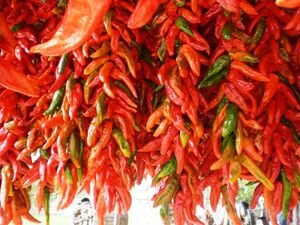Peperone di Senise (Senise pepper)

IGP Peperone di Senise is an Italian pepper obtained from the cultivation of Capsicum annuum, a Solanaceae that originally came from the Americas. A particularly hardy plant, it adapted itself well to the soil and climatic conditions of Italy, especially those in the south, although dependent on the availability of water. The pepper grown in Senise is not ascribable to any officially recognised cultivar, but there is an ecotype which is found locally. The fruit of the peperone di Senise is characterised by a thin wall and a low water content, which allows rapid drying through natural methods by direct exposure to sunlight. The peperone di Senise is marketed for consumption both fresh and as a processed product. The fresh product comes in the types: "pointed", "truncate" and "hooked". The processed product is found in "strings" of sun-dried fruits or in a fine "powder" obtained by grinding the dried fruits.
GEOGRAPHICAL AREA:
The geographical indication production area includes the suitable areas of the communes of Senise, Francavilla S.S., Chiaromonte, Valsinni, Colobraro, Tursi, Noepoli, Sgiorgio Lucano, Sant'Arcangelo, Roccanova, Montalbano Jónico e Graco.
EVIDENCE OF ORIGIN:
The peperone di Senise has been grown in the defined area for centuries. The pepper is a characteristic element of Lucanian gastronomic traditions. Numerous bibliographic sources identify and establish the original production area.
ACQUISITION:
Sowing takes place from the last ten days of February to the second ten days of March. Transplanting is done after the second ten days of May. Harvesting is done manually during or after the first ten days of August, when the fruits reach their typical red colour.
LINK:
The "peperone di Senise" has a unique character which, due to the particular soil and environmental conditions of the production area, greatly differentiates it from other products of the same species, with characteristics of excellence and quality. From time immemorial the original production area of the peperone di Senise has been ideal for growing vegetables, being a well-irrigated area of ancient tradition and with soil and climatic conditions particularly suited to the requirements for pepper cultivation. Therefore the Senise area is definitely one of the areas where pepper growing was successfully introduced long ago, and where the pepper plant adapted itself to the soil and environment, keeping much of the hardiness of the first "plants" brought into the area. In particular, the peperone di Senise has a very important characteristic, which is that the stem does not detach from the fruit even after drying. This makes it possible to tie the fruits together to make the typical "strings".
Reference: The European Commission